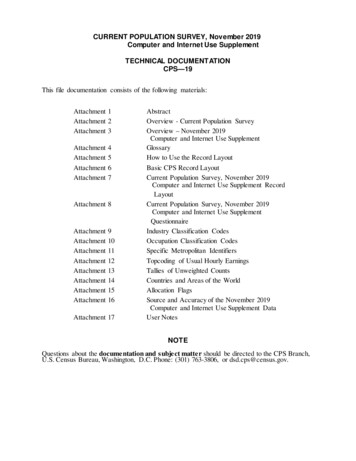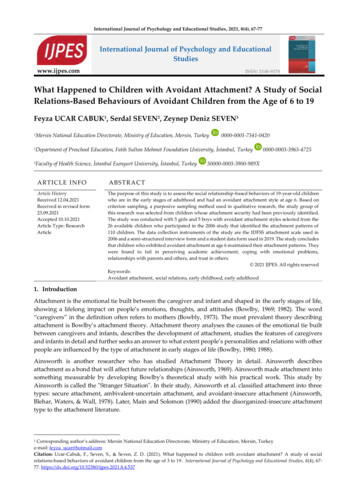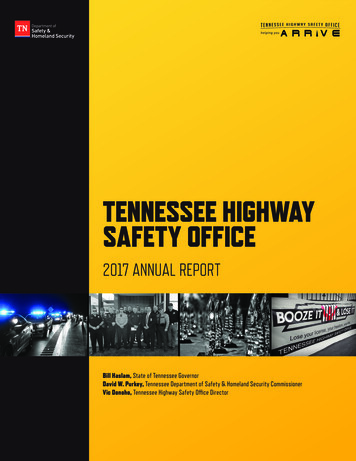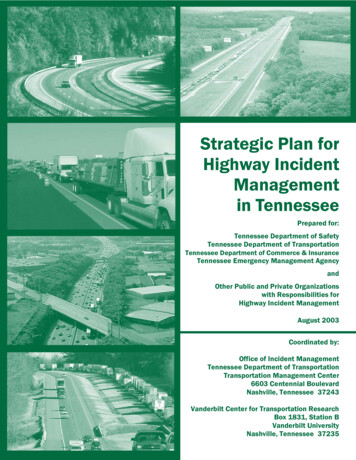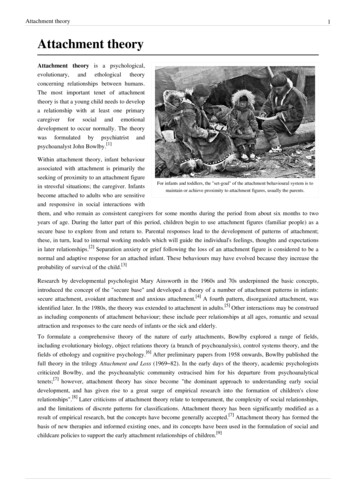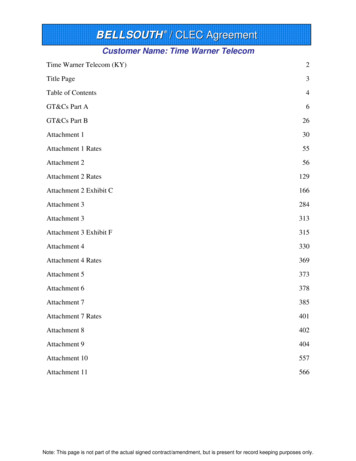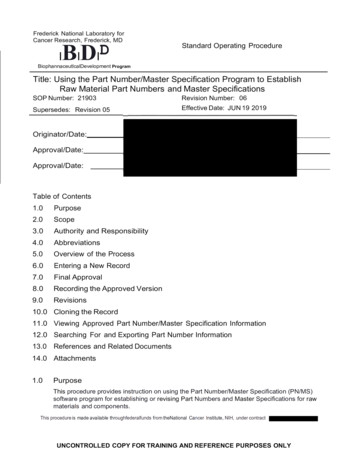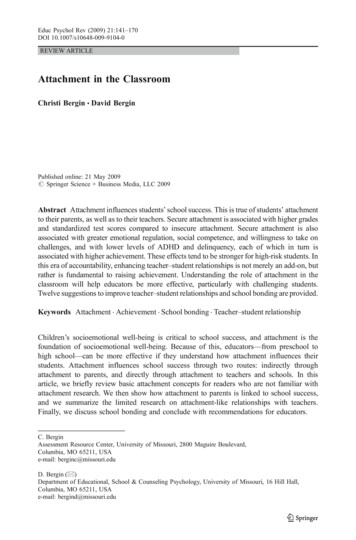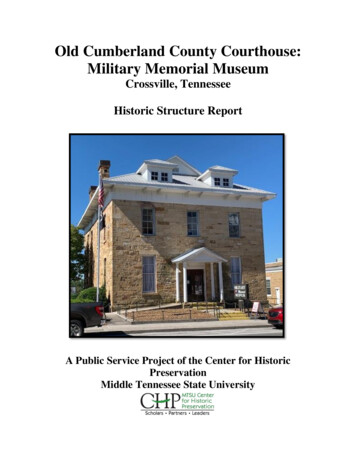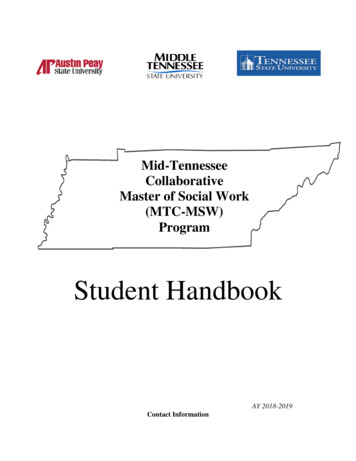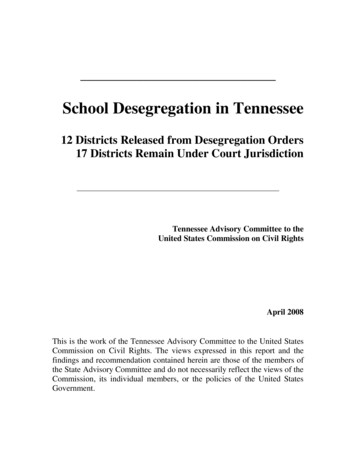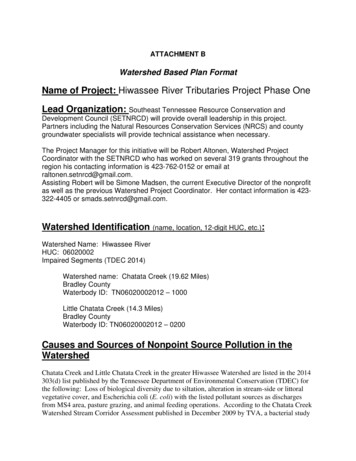
Transcription
ATTACHMENT BWatershed Based Plan FormatName of Project: Hiwassee River Tributaries Project Phase OneLead Organization: Southeast Tennessee Resource Conservation andDevelopment Council (SETNRCD) will provide overall leadership in this project.Partners including the Natural Resources Conservation Services (NRCS) and countygroundwater specialists will provide technical assistance when necessary.The Project Manager for this initiative will be Robert Altonen, Watershed ProjectCoordinator with the SETNRCD who has worked on several 319 grants throughout theregion his contacting information is 423-762-0152 or email atraltonen.setnrcd@gmail.com.Assisting Robert will be Simone Madsen, the current Executive Director of the nonprofitas well as the previous Watershed Project Coordinator. Her contact information is 423322-4405 or smads.setnrcd@gmail.com.Watershed Identification (name, location, 12-digit HUC, etc.):Watershed Name: Hiwassee RiverHUC: 06020002Impaired Segments (TDEC 2014)Watershed name: Chatata Creek (19.62 Miles)Bradley CountyWaterbody ID: TN06020002012 – 1000Little Chatata Creek (14.3 Miles)Bradley CountyWaterbody ID: TN06020002012 – 0200Causes and Sources of Nonpoint Source Pollution in theWatershedChatata Creek and Little Chatata Creek in the greater Hiwassee Watershed are listed in the 2014303(d) list published by the Tennessee Department of Environmental Conservation (TDEC) forthe following: Loss of biological diversity due to siltation, alteration in stream-side or littoralvegetative cover, and Escherichia coli (E. coli) with the listed pollutant sources as dischargesfrom MS4 area, pasture grazing, and animal feeding operations. According to the Chatata CreekWatershed Stream Corridor Assessment published in December 2009 by TVA, a bacterial study
conducted by University of Tennessee Knoxville indicated that 80% of fecal contaminationwithin this specific watershed is from bovine sources.Chatata Creek enters the Hiwassee River at mile 23.9. The state has listed 19.62 miles ofChatata Creek and 14.63 miles of Little Chatata Creek as not meeting designated usages. TVAhas tested these waters in addition to the TDEC testing and has confirmed a consistently scored“high poor”.Fifty percent of the 43 square miles that the Chatata Creek watershed covers is deemedunsuitable for agriculture. 35% of the watershed is used for agricultural purposes with 7.3% asrow crops and 5.5% designated as urban land use. TVA published a report on the Chatata Creekin 2009 which listed a number of sites that could use improvements. Although this reportfocusses primarily on siltation, barriers, channel alteration, and trash dumping sites, it doesprovide insight into what the Stream Corridor Assessment views as potential problems. We willbe visiting this document to determine if the sites suggested by the SCA survey can go hand inhand with our projects in creating stream buffers or other BMPs.The TMDL issued in 2006 for the Hiwassee River listed two sites on Chatata creek whosecoliform microbial density was averaged. One site showed an average of 946 counts per 100mL, another testing site showed 2,841 counts per 100 mL on average with a maximum amount of23,590 counts per 100 mL. Fecal coliform testing was not done at the first site, but for the latterand there was an average of 3,053 counts per 100 mL.As mentioned previously, the majority of E. coli being deposited into Chatata Creek is due tolocal livestock. In this watershed, the TMDL issued on 2006 listed 1,500 beef cows and 425milk cows in Chatata Creek. In Little Chatata Creek, there are 1,350 beef cows and 475 milkcows. In addition to this, there are also a number of poultry CAFOs in each watershed, a fewhog operations, and a small number of sheep and horses. However, due to the TMDL issued andour previous knowledge in working with other distributors, we will be putting our primary focuson the cattle operations in order to reduce the greatest amount of E. coli being deposited into thestream.Another portion of our grant will be dedicated to fixing failed septic systems. The TMDL issuedshows that 4,477 families on the Chatata Creek have septic systems and 1,374 families on LittleChatata Creek are on septic systems. It is safe to assume that a number of these septic systemshave failed and are in need of repair based on the assessment of TVA’s 2009 findings.Estimate of Load ReductionsThe primary cause of the 303(d) listing for these creeks are E. coli contamination, and as suchour BMPs will focus on reducing E. coli. With the severe droughts, we have been experiencingin the area, much of the pasture may be damaged with soil exposed. We are planning to do anumber of forage and biomass planting in fields as both an incentive for farmers to work with usas well as a way to reduce the amount of sediment and runoff being flushed into streams.PracticeCodePractice Name UnitAmountLbs./NPer YearLbs./PPerTons ofSediment
614516WateringSystemHeavy UseAreaPipeline382Fence512Forage t7,0001,164.6129.425.889101404220,500 ft5,125410123300 acres 269.05 1,280.1Per Year.006332.486.BMP List, Educational Activities and BudgetBMP NameQuantityCost/UnitBudget EstimateWatering System15 1,142.40 17,136Heavy Use Area12,940 sq/ft 3.58 46,325.2Pipeline7,000 2.50 17,500Fence20,500 ft 2.73 55,965Forage and Biomass Planting300 acres 358.61 107,583Septic Improvements25 5000 125,000Educational EventQuantityCost/UnitBudget EstimateAgricultural Workshop2 0 0Septic Installer Workshop1 0 0Residential Septic System Workshop1 0 0Nonpoint Source Pollution Events3 0 0Total Budget for Project: 369,509.20
*Cost estimated from 2015 EQIP Payment Schedule and previous area estimates for septicrepairsTimeline, Tasks, and Assessment of ProgressWithin the first two months we will reach out to farmers who were previously interested in thegrant that were not within watersheds we previously served. In the first three months, we plan tohave one of the farmer workshops, this is especially important to advertise the forage andbiomass BMPs in a timely fashion to meet planting time tables as the recent severe drought hascaused quite a bit of damage to grazing fields. Another farmer BMP workshop will be done inthe next year. The workshop with septic installers and residents will be done within the first sixmonths. We are planning to do at minimum 25 septic system repairs, however this may changeif we get an increased amount of interest – we may reduce the cost share to accommodate forincreased interest.Progress will be measured month to month with the nonprofit’s board overseeing and approvingvouchers and project coordinator’s work. Every fiscal quarter we will send in quarterly reportsas required by the state, alongside financial reimbursement requests unless we require them on amore immediate basis. On September 15th of every year we will submit to the state a documentsummarizing our work containing four separate photos called “4x4s”. At the end of the grantcycle we will publish our close out report which will contain a summary of what we have done,problems that we have encountered, and how, in the future, those problems could be avoided.Towards the end of the grant cycle we will begin planning Phase II for work on another stream inthe Hiwassee Watershed in order to continue our work to reduce the overall total amount of E.coli going into the Hiwassee. We will work from the headwaters of tributaries down to the riveritself. The plan is to visit the majority of the watershed over time in order to improve waterquality of the Hiwassee River as well as its tributaries.Criteria to Assess Achievement of Load Reduction GoalsWe will work with TDEC and ground water specialists in order to measure the improvementsthat our practices have made. We will provide a list of the locations and practices installed, andsee after implementation if water quality has been improved. These results will be seen in anyfuture TMDL or 303(d) listings or delistings. Additionally, these BMPs will have an estimatedload reduction as seen in the Estimated Load Reduction section of this Watershed Based Planwhich uses information provided in the FY2017 319 RFP for constructing these plans.Monitoring and Documenting Success
Success of this project is based off of the BMPs installed which are known to reduce the amountof E. coli contamination in the creek. Additionally, we will also see reduction in erosion andsedimentation in the creek as a consequence of installing these BMPs – both of which areimportant in the improvement of overall water quality, where sedimentation likely impacts theability of E. coli to subsist in the water column. We will submit all records to the state officedefining the BMPs installed as well as their location.
the Hiwassee Watershed in order to continue our work to reduce the overall total amount of E. coli going into the Hiwassee. We will work from the headwaters of tributaries down to the river itself. The plan is to visit the majority of the watershed over time in order to improve water quality of the Hiwassee River as well as its tributaries.
